
Ivory is a hard, white material from the tusks and teeth of animals, that consists mainly of dentine, one of the physical structures of teeth and tusks. The chemical structure of the teeth and tusks of mammals is the same, regardless of the species of origin. The trade in certain teeth and tusks other than elephant is well established and widespread; therefore, "ivory" can correctly be used to describe any mammalian teeth or tusks of commercial interest which are large enough to be carved or scrimshawed.
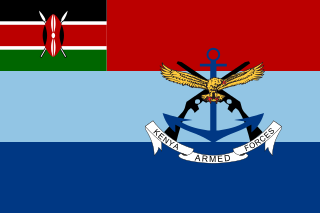
The Kenya Defence Forces (KDF) are the armed forces of the Republic of Kenya. They are made up of the Kenya Army, Kenya Navy, and Kenya Air Force. The current KDF was established, and its composition stipulated, in Article 241 of the 2010 Constitution of Kenya; it is governed by the KDF Act of 2012. Its main mission is the defence and protection of the sovereignty and territorial integrity of Kenya, recruitment to the KDF is done on yearly basis. The President of Kenya is the commander-in-chief of the KDF, and the Chief of Defence Forces (Kenya) is the highest-ranking military officer, and the principal military adviser to the President of Kenya and the National Security Council. The KDF is regularly deployed in peacekeeping missions in Africa and further afield for example peace keeping missions in Somalia since 2011.
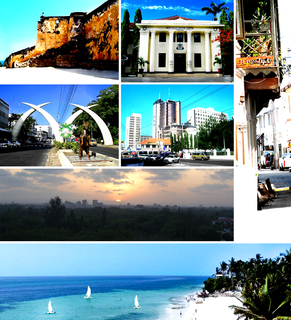
Mombasa is a coastal city in southeastern Kenya along the Indian Ocean. The city is known as the white and blue city in Kenya. It is the country's oldest and second-largest city, with a population of about 1,208,333 people according to the 2019 census. Its metropolitan region is the second-largest in the country, and has a population of 3,528,940 people.

Eldoret is a principal town in the Rift Valley region of Kenya and serves as the capital of Uasin Gishu County. The town is colloquially known as 'Sisibo'. As per the 2019 Kenya Population and Housing Census, Eldoret is the fifth most populated urban area in the country after Nairobi, Mombasa, Nakuru and Ruiru. Lying south of the Cherangani Hills, the local elevation varies from about 2100 meters at the airport to more than 2700 meters in nearby areas (7000–9000 feet). The population was 289,380 in the 2009 Census, and it is currently the fastest growing town in Kenya with 475,716 people according to 2019 National Census.
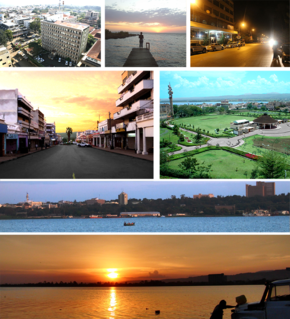
Kisumu is the third-largest city in Kenya after the capital, Nairobi, and the coastal city of Mombasa. It is the third-largest city in the Lake Victoria Basin. Kisumu is not far from Kogelo, a village known for being the hometown of Barack Obama Sr., the father to the 44th president of the United States. Culturally, Kisumu serves as the headquarters of the Luo speaking people of East Africa. It was the most prominent urban centre in the pre-colonial, post-colonial, and modern era for natives of Kavirondo region. Some of the most significant political events that have shaped the trajectory Kenya have happened in Kisumu including the famous political spat between founding president of Kenya Jomo Kenyatta and founding vice president Jaramogi Odinga during the opening of Jaramogi Oginga Odinga Teaching and Referral Hospital in 1969. Apart from being an important political city, it is one of the premier industrial and commercial centres in Kenya. The city is currently undergoing an urban rejuvenation of the downtown and lower town which includes modernizing the lake front, decongesting main streets, and making the streets pedestrian-friendly.

Moi International Airport is an international airport in Mombasa, the second-largest city in Kenya. The other three important international airports in Kenya include the Jomo Kenyatta International Airport (JKIA) in Kenya's capital city, Nairobi, the Kisumu International Airport (KIA) in Kisumu, Kenya's third largest city and the Eldoret International Airport (EIA) in Eldoret. It is located in Mombasa County in a township called Port Reitz, and features regional as well as intercontinental flights. The Airport is awarded as the "Best Airport in Africa"-2020 by Airports Council International

Moi Avenue is a primary thoroughfare in Mombasa, Kenya. The road runs from west to east from Kilindini to a roundabout with Digo Road. Originally called the Kilindini Road, its name was later changed in recognition of Kenya's second President, Daniel arap Moi. The road consists of two two-lane carriageways, and like Jomo Kenyatta Avenue, a central median of approximately 3 feet (1 m) in width, along which flowers and shrubs are often planted.
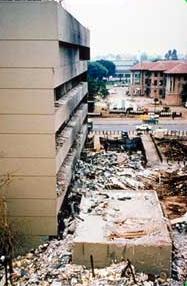
There is a high rate of crime in all regions of Kenya, particularly in Nairobi, Mombasa, Kisumu, and coastal beach resorts. There are regular reports of attacks against tourists by groups of armed assailants. However, the most common crime in Kenya is carjacking so the criminal can commit an armed robbery. "Snatch and run" crimes are becoming more common on city streets.

The ivory trade is the commercial, often illegal trade in the ivory tusks of the hippopotamus, walrus, narwhal, mammoth, and most commonly, African and Asian elephants.

Elephant hunting, which used to be an accepted activity in Kenya, was banned in 1973, as was the ivory trade. Illegal hunting continues, as there is still international demand for elephant tusks. Kenya pioneered the destruction of ivory as a way to combat this black market. Elephant poaching continues to pose a threat to the population.

Elizabeth II was Queen of Kenya from 1963 to 1964, when Kenya was independent sovereign state with a constitutional monarchy. She was also the sovereign of the other Commonwealth realms, including the United Kingdom. Her roles as the Kenyan head of state were delegated to the governor-general of Kenya.

China–Tanzania relations refer to the foreign relations between China and Tanzania. China established diplomatic relations with Tanganyika and Zanzibar on December 9, 1961, and December 11, 1963, respectively. When Tanganyika and Zanzibar were united and became Tanzania on April 26, 1964, China extended its diplomatic ties to it.
Jim Nyamu, of Nairobi, Kenya, is an elephant research scientist and activist against poaching and trade in ivory. Nyamu is the executive director at the Elephant Neighbors Center (ENC) and is leader of the movement, Ivory Belongs to Elephants. He has also held positions at the African Conservation Centre and Kenya Wildlife Service. The ENC is a grass-roots collaborative and participatory research organization focused on enhancing the capacity of communities living with wildlife to promote interlinkages between species and their habitats.

Satao was one of Kenya's largest African elephants. He was known as a tusker because his tusks were so long that they almost touched the ground. The Tsavo Trust announced that Satao was killed by poachers using a poisoned arrow on 30 May 2014.
The Mombasa–Nairobi Standard Gauge Railway is a standard-gauge railway (SGR) in Kenya that connects the large Indian Ocean city of Mombasa with Nairobi, the country's capital and largest city. This SGR runs parallel to the narrow-gauge Uganda Railway that was completed in 1901 under British colonial rule. The East African Railway Master Plan provides for the Mombasa–Nairobi SGR to link with other SGRs being built in the East African Community.
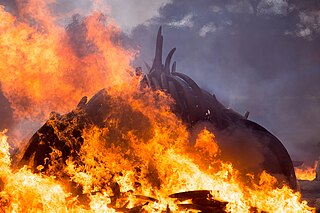
The destruction of ivory is a technique used by governments and conservation groups to deter the poaching of elephants for their tusks and to suppress the illegal ivory trade. As of 2016, more than 263 tonnes (580,000 lb) of ivory has been destroyed, typically by burning or crushing, in these high-profile events in 21 countries around the world. Kenya held the first event in 1989, as well as the largest event in 2016, when a total of 105 tonnes (231,000 lb) of ivory were incinerated.
Muthoni wa Kirima was a top-raking female fighter in Kenya's liberation movement Mau Mau or Land Freedom Army in the 1950. She is the only woman said to have been bestowed the Mau Mau rank of field-marshal. She was one of the very few women to become active fighters in the liberation movement.
The Mombasa–Nairobi Expressway or Nairobi–Mombasa Expressway, also known as the Nairobi–Mombasa Highway, is a proposed four-lane toll highway in Kenya. The highway will link Nairobi, the capital and largest city of Kenya to Mombasa, the largest seaport of the country. The new highway is expected to cut travel times between the two cities from the current 6 to 10 hours to approximately four hours.
List of events from the year 2021 in Kenya.
Mombasa Cement Limited (MCL) is an industrial company in Kenya specialising in the manufacture of construction materials. The company has operations in Nairobi, Athi River and Kilifi, it is headquartered in Mombasa. The company is a privately owned business. Mombasa Cement Ltd is one of the largest manufacturer of cement in Eastern Africa, with the company controlling 20% of the market share in the Kenyan cement sector (2020).














